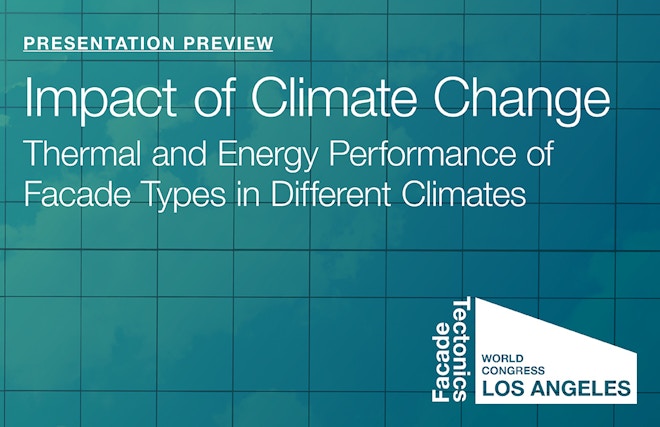Read Impact of Climate Change: Thermal and Energy Performance of Facade Types in Different Climates prior to Aksamija’s presentation at the 2016 World Congress.
Impact of Climate Change: Thermal and Energy Performance of Facade Types in Different Climates copy

On October 10th - 11th, the Facade Tectonics Institute will present Face Time: The Emergence of Facade as the Integrative Factor in Holistic Building Design at the Sheraton Grand Los Angeles. The two-day event is the Institute’s 2016 Annual Conference and inaugural World Congress, and promises deeply informative technical presentations from leading minds in the architecture, engineering and construction industry. With nearly 100 speaker presentations divided between eight sessions and five speaking tracks, Face Time will combine the art, science and technology of the building skin with an unparalleled networking opportunity from the domestic and international building community. Leading up the event, the Institute will release research papers by select presenters.
As global temperatures continue to rise, researchers are examining the building envelope’s impact on climate-specific guidelines to create a more sustainable built environment. On Monday, October 10th, author Ajla Aksamija of the University of Massachusetts Amherst and Perkins+Will will share her design strategies to minimize the impacts of external environmental conditions and reduce energy consumption in Impact of Climate Change: Thermal and Energy Performance of Facade Types in Different Climates. The abstract from her research paper — which was coauthored by Troy Peters of the Wentworth Institute of Technology — is below:
The facade is one of the most significant contributors to the energy budget and the comfort parameters of any building. Control of physical environmental factors must be considered during the design process. High-performance facades need to block adverse external environmental effects and maintain internal comfort conditions with minimum energy consumption. This research was conducted by modeling conductive heat transfer in five different exterior wall types (brick cavity wall, rainscreen facade with terracotta cladding, rainscreen facade with glass-fiber reinforced concrete cladding, curtain wall, and a curtain wall with thermally broken framing), where U-values were compared to determine thermal performance. Impacts on energy use were also investigated, where energy usage was modeled for an office space enclosed with the analyzed facade types for all U.S. climate zones and 12 orientations, and for window-to-wall ratio of 20% and 40%, using historical weather data. The results show relative performance of analyzed exterior wall types, in terms of thermal performance and energy usage. Then, future climate conditions were considered, where the impacts of climate change on changing weather patterns were investigated. Specifically, predicated climate change weather files for the years 2050 and 2080 were used to model energy usage for the office space enclosed with analyzed exterior wall types. The results show the impacts of climate change on the energy performance, and show that typically the energy usage is increased.
Looking for something specific?
Search our extensive library.
FTI’s SKINS email is the central source for the latest in building skin trends and research.
All emails include an unsubscribe link. You may opt out at any time. See our privacy policy.









